
Content
Welcome to the Club of Amsterdam Journal. “Consciousness is widely viewed as the last frontier of science. Modern science may have split the atom and solved the mystery of life, but it has yet to explain the source of conscious feelings. Eminent thinkers from many areas of science are turning to this problem, and a wide range of theories are currently on offer. Yet sceptics doubt whether consciousness can be tamed by conventional scientific techniques, and others whether its mysteries can be understood at all.” – 21st Century Join our discussion about the future of Consciousness on January 25 |
The Future Evolution of Consciousness
If the evolutionary advantage of consciousness is that it “improves the capacity to develop novel adaptive responses”, then further improvements should continue to offer an advantage. One of the specific improvements needed, according to the paper, is the ability to prevent goals supported by the “hedonic system” from controlling sequences of thoughts and behavior. Interestingly, the author concludes that this is exactly what organized religion has been trying to do for thousands of years. This could mean that beings (humans or robots) with consciousness augmented by religion have an evolutionary advantage. Like Daniel Dennett, Stewart believes scientific study of religion should be a priority of scientists.
The Future Evolution of Consciousness
By John Stewart
ABSTRACT
What potential exists for improvements in the functioning of consciousness? The paper addresses this issue using global workspace theory. According to this model, the prime function of consciousness is to develop novel adaptive responses. Consciousness does this by putting together new combinations of knowledge, skills and other disparate resources that are recruited from throughout the brain. The paper’s search for potential improvements in the functioning of consciousness draws on studies of the shift during human development from the use of implicit knowledge to the use of explicit (declarative) knowledge. These studies show that the ability of consciousness to adapt a particular domain improves significantly as the transition to the use of declarative knowledge occurs in that domain. However, this potential for consciousness to enhance adaptability has not yet been realised to any extent in relation to consciousness itself. The paper assesses the potential for adaptability to be improved by the conscious adaptation of key
processes that constitute consciousness. A number of sources (including the practices of religious and contemplative traditions) are drawn on to investigate how this potential might be realised.
1. INTRODUCTION
An improved capacity to develop novel adaptive responses has often been given as the reason why evolution favoured the emergence of consciousness. Consciousness is increasingly seen as a process that confers evolutionary advantage by enhancing the ability of an organism to discover new and better behavioural adaptations (Baars 1988; Dennett 1991; Metzinger 2003 and DeHaene and Naccache 2001).
Global Workplace (GW) theory attributes this capacity of consciousness to its ability to assemble novel combinations of knowledge, skills and other resources for the development of new adaptive responses (Baars 1983, 1988 and 1997). This enables consciousness to, for example, recruit the resources needed to construct composite mental representations of alternative responses and their consequences, enabling the most adaptive response to be identified.
This paper explores the extent to which the adaptability conferred by consciousness can be enhanced in humans. In particular, it seeks to identify the potential for changes in the functioning of consciousness to improve its ability to discover better behavioural adaptations.
Addressing this issue has been greatly assisted by the recent development of information processing theories of the functioning of consciousness. An understanding of consciousness from an information processing perspective enables us to assess its potential for further improvement. We can judge how well consciousness performs its functions, and whether changes in the processes that constitute consciousness could overcome any limitations and enhance its ability to adapt behaviour effectively.
This paper uses the information processing framework embodied in GW theory to assess the potential for improvement in consciousness. Of the competing information processing accounts of consciousness, it currently attracts the widest support (Baars 2002; DeHaene and Naccache 2001; Kanwisher 2001; and Dennett 2001).
The paper focuses on those improvements that can emerge through the processes of cultural evolution, rather than through genetic change. It therefore considers only changes that can be learnt and can be transmitted culturally.
We begin in Section 2 by outlining and developing the main features of Baars’ GW theory that are relevant to our task. This analysis of GW theory is drawn on in Section 3 to identify how the functioning of conscious processes might be improved to enhance the adaptability and evolvability of humans. The search for potential improvements is aided by developmental research that identifies how adaptability is significantly enhanced in other domains when declarative knowledge is used to assist adaptation. In section 4 we use GW theory and other sources to begin to identify practices and experiences that could enable humans to acquire skills and capacities that would realise the potential to improve the functioning of consciousness.
[…]
4. CONCLUSION
Religious and contemplative traditions have accumulated a substantial body of declarative and procedural knowledge about how to modify the functioning of consciousness. This knowledge has the potential to significantly increase human adaptability and evolvability. By enabling conscious processes to be modified, it opens the way for declarative modelling to optimise the functioning of consciousness. This would enable the full capacity of consciousness to discover new adaptations to be used to adapt and enhance consciousness itself. However, the development of these capacities would not just significantly enhance adaptability – it would also change what occupies the GW through time, and therefore what an individual is conscious of. It would change the experience of what it is to be a human being.
However, the explanations and interpretations developed by the contemplative traditions to account for the practices they use and the experiences and capacities they produce are prescientific. Their theories have not been disciplined by the scientific method. In particular, they have unnecessarily introduced a plethora of theoretical entities unknown to empirical psychology and science that have little predictive value. Nor have the theories taken advantage of the powerful models and understandings embodied in standard learning theory, clinical psychology, information processing models of cognition, and other areas of cognitive neuroscience.
It can be expected that these deficiencies will be corrected as the knowledge accumulated by the contemplative traditions is integrated into the framework and practice of scientific psychology. As this integration proceeds, it is likely that far more powerful models of the phenomenon and associated processes will be developed, and that these in turn will enable more effective practices and interventions to be developed. Such a re-interpretation of pre-scientific declarative and procedural knowledge in the light of the conceptual frameworks and models of other domains is an important step in the declarative transition in any domain. In particular, it enables discoveries, models and understandings from other areas to be applied to the domain in question, and vice versa. Science has been the key vehicle for this process in the most recent 400 years of human evolution. This paper is a contribution to the early stages of this interpretation and integration process for consciousness (see Walsh and Shapiro 2006 for a recent overview of progress).
The integration of the discoveries of contemplative traditions with scientific psychology can be expected to greatly assist and accelerate the unfolding of this declarative transition across humanity in general. The successful accomplishment of the transition would open up adaptive possibilities of great evolutionary significance. It would, for example, provide humans with the possibility of choosing to pursue evolutionary goals directly, rather than continuing to pursue proxies for evolutionary success. It would also enable these goals to be pursued more creatively and successfully. Furthermore, as the transition extends to more aspects of consciousness, humans would increasingly be able to choose to adopt particular modes of consciousness to match the needs of different circumstances, just as we now can choose to adopt particular physical postures to match the needs of different physical tasks.
You can download the full paper as a *.pdf click here
International LABs
| LAB on Old and New ENERGY An immersed experience of a Do-Tank April 17 & 18, 2007 Location: Girona near Barcelona, Spain Max. 20 Delegates Moderated by Humberto Schwab, Director, Club of Amsterdam, Innovation Philosopher and the Thought Leaders Nathalie Horbach, Centre for Energy, Petroleum and Mineral Law and Policy, University of Dundee Nuclear policies specialist Simon Taylor, Director and Co-Founder, Global Witness Environmental issues Christof van Agt, International Energy Agency Sustainable energy specialist Paul Holister, Nanotechnology & Energy |
News about the future of Consciousness

Religion is intimately interwoven with human biology
There is reason to believe that, to some degree, spirituality is hard-wired into the human nervous system.
Recent experiments using thermal imaging indicate that brain activity during a “transcendent” experience is highest in the limbic system, that part of the brain which is associated with emotions and motivation, and in the connecting hypothalamus, amygdala and the hippocampus. Neurobiologists Andrew Newberg and Eugene d’Aquili have conducted research in the field of “neurotheology” using brain imaging technology ( Single Photon Emission Computed Tomography, or SPECT for short ).
They suggest that “religion is intimately interwoven with human biology.” Their studies of praying Franciscan nuns and meditating Buddhist monks reveal that certain religious experiences, like meditation and prayer, are linked to increased activity and changes in the structure of the brain and nervous system.

The Mystery of Consciousness
by Steven Pinker in Time Magazine
[…] As every student in Philosophy 101 learns, nothing can force me to believe that anyone except me is conscious. This power to deny that other people have feelings is not just an academic exercise but an all-too-common vice, as we see in the long history of human cruelty. Yet once we realize that our own consciousness is a product of our brains and that other people have brains like ours, a denial of other people’s sentience becomes ludicrous. “Hath not a Jew eyes?” asked Shylock. Today the question is more pointed: Hath not a Jew–or an Arab, or an African, or a baby, or a dog–a cerebral cortex and a thalamus? The undeniable fact that we are all made of the same neural flesh makes it impossible to deny our common capacity to suffer. […]
Club of Amsterdam blog
 | Club of Amsterdam blog February 12: Innovation – a hybrid connection between old practices? January 8: The Future of Consciousness December 18: selflead December 14: On the Art of Value-Webbing |
News about the Future

VBOX
The Venue VBOX – basically a huge shipping container that can be tricked out with cool features and even cooler products – is taking the idea of pop-up retail stores to an extreme.
“The VBOX enables a brand or company to follow an event they wish to align their brand with, or pop up where consumers least expect it. Tag along with a photography exhibition or set up shop temporarily at a large sporting event. Brands can even showcase items that consumers may not otherwise be able to purchase elsewhere: just fill the VBOX with one-offs or special editions and you’ll pull in consumers with the prospect that they’ll able to purchase something unique.
The VBOX comes self-contained and equipped with an iMac and iPod HiFi. It’s entirely ready to go; all that needs to be done is fill it with enticing products. To date the VBOX has housed collections by some of the fashion world’s most prestigious names: RAF SIMONS (Prada Group) and limited PUMA designer co-labs by Alexander McQueen, Christy Turlington, Mihara Yasuhiro as well as CDs, magazines/books and Motorola phones.”

MIT researchers unveiled a new social networking application that will make it possible for anyone on the Institute’s 168-acre campus to locate anyone else, via their laptop.
Known as iFIND, the new technology was developed by researchers in the Institute’s SENSEable City Laboratory.
Carlo Ratti, director of the SENSEable City Lab, described this new form of social networking as “friendspotting”: “Imagine coming out of a class in a faraway corner of the MIT campus, and instantly knowing which friends are nearby, or being able to dynamically schedule an appointment with a faculty member based on his or her proximity to you,” he said.
With almost 3,000 WiFi access points, the MIT campus is one of the most densely networked areas in the world. Such connectivity has changed the nature of social encounters on campus.
Next Season Event
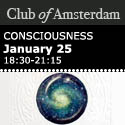 the future of Consciousness Thursday, January 25, 2007 Registration: 18:30-19:00, Conference: 19:00-21:15 Where: EnlightenNext, Oudeschans 46a, 1011 LC Amsterdam Mauk Pieper, Trainer, Coach, Teacher Cultural development and the development of man as a new more conscious being have to go hand in hand. Arjan Kindermans, EnlightenNext Amsterdam Transcending and including individualism, how do you do that? George Pór , Founder, CommunityIntelligence Ltd. What Color is Your Collective Intelligence? Moderated by Homme Heida, Promedia, Member of the Club of Amsterdam Round Table |

Recommended Book

The Sacred Depths of Nature
by Ursula GoodenoughUrsula Goodenough is an internationally recognized cell biologist; she is also an accomplished amateur theologian–an unusual combination of interests in a time when science and religion are widely divided. In The Sacred Depths of Nature, she proposes what she calls a “planetary ethic” drawing on the lessons of both science and metaphysics, celebrating some of the mysteries that are central to both: “the mystery of why there is anything at all, rather than nothing,” for one, and “the mystery of why the universe seems so strange,” for another. Exploring scientifically based narratives about the creation of the universe and the origins of life, Goodenough forges a kind of religious naturalism that will not be unfamiliar to readers of New Age literature–save that her naturalism has the hard-nosed rigor of a laboratory-trained scholar behind it. Goodenough offers a crash course in the life sciences for her readers, encompassing the basics, for instance, of biochemistry in just a few paragraphs (and getting it right in the bargain), touching on Darwinian biology and population dynamics and even chaos theory to make “an epic of evolution” that has all the hallmarks of an origin myth. Faith and reason, in her view, are not mutually exclusive, and her well-written treatise makes a good argument for bridging the gap between the two.
Architecture for Kids
Rolling Bridge
SKM Anthony Hunts
Paddington Basin
London, UK
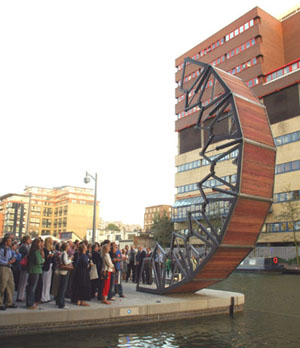
The Cardboard House
Stutchbury and Pape, working in association with the Ian Buchan Fell Housing Research Unit at University of Sydney

Bubbletecture Maihara Kindergarten
Shiga Shuhei Endo Architect Institute
Maihara-cho, Shiga
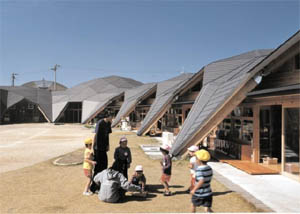
World Energy Technology Outlook – 2050
By European Commission
KEY MESSAGES
The WETO-H2 study has developed a Reference projection of the world energy system and two variant scenarios, a carbon constraint case and a hydrogen case. These scenarios have been used to explore the options for technology and climate policies in the next half-century.
All the projections to 2050 have been made with a world energy sector simulation model – the POLES model – that describes the development of the national and regional energy systems, and their interactions through international energy markets, under constraints on resources and climate policies.
The development of the world energy system in the reference projection
The reference projection
The Reference projection describes a continuation of existing economic and technological trends, including short-term constraints on the development of oil and gas production and moderate climate policies for which it is assumed that Europe keeps the lead.
World energy consumption
The total energy consumption in the world is expected to increase to 22 Gtoe per year in 2050, from the current 10 Gtoe per year. Fossil fuels provide 70% of this total (coal and oil 26% each, natural gas 18%) and non-fossil sources 30%; the non-fossil share is divided almost equally between renewable and nuclear energy.
Energy efficiency improvement
The size of the world economy in 2050 is four times as large as now, but world energy consumption only increases by a factor of 2.2. The significant improvement in energy efficiency arises partly from autonomous technological or structural changes in the economy, partly from energy efficiency policies and partly from the effects of much higher energy prices.
North-South balance in energy consumption
Energy demand grows strongly in the developing regions of the world, where basic energy needs are at present hardly satisfied. The consumption in these countries overtakes that of the industrialised world shortly after 2010 and accounts for two thirds of the world total in 2050.
Oil and gas production profiles
Conventional oil production levels off after 2025 at around 100 Mbl/d. The profile forms a plateau rather than the “peak” that is much discussed today. Non-conventional oils provide the increase in total liquids, to about 125 Mbl/d in 2050. Natural gas shows a similar pattern, with a delay of almost ten years.
Oil and gas prices
The prices of oil and natural gas on the international market increase steadily, and reach 110 $/bl for oil and 100 $/boe for gas in 2050. The high prices mostly reflect the increasing resource scarcity.
Electricity: the comeback of coal, the take-off of renewable sources and the revival of nuclear energy
The growth in electricity consumption keeps pace with economic growth and in 2050, total electricity production is four times greater than today. Coal returns as an important source of electricity and is increasingly converted using new advanced technologies. The price of coal is expected to reach about 110 $/ton in 2050. The rapid increase of renewable sources and nuclear energy begins after 2020 and is massive after 2030; it implies a rapid deployment of new energy technologies, from large offshore wind farms to “Generation 4” nuclear power plants.
CO2 emissions
The deployment of non-fossil energy sources to some extent compensates for the comeback of coal in terms of CO2 emissions, which increase almost proportionally to the total energy consumption. The resulting emission profile corresponds to a concentration of CO2 in the atmospheric between 900 to 1000 ppmv in 2050. This value far exceeds what is considered today as an acceptable range for stabilisation of the concentration.
The European energy system in the reference projection
Energy demand trends
Total primary energy consumption in Europe increases only a little from 1.9 Gtoe / year today to 2.6 Gtoe / year in 2050. Until 2020, the primary fuel-mix is rather stable, except for a significant increase in natural gas consumption. Thereafter the development of renewable energy sources accelerates and nuclear energy revives. In 2050 non-fossil energy sources, nuclear and renewable provide 40% of the primary energy consumption, much above the present 20%. The consumption of electricity keeps pace with economic growth; the market for electricity remains dynamic because of new electricity uses, especially in the Information and Communication Technologies.
CO2 emissions
This combination of modest climate policies and new trends in electricity supply results in CO2 emissions that are almost stable up to 2030 and then decrease until 2050. At that date CO2 emissions in Europe are 10% lower than today.
Electricity production
Because of relatively strong climate policies, European electricity production is 70% decarbonised in 2050; renewable and nuclear sources provide 60% of the total generation of electricity and a quarter of thermal generation is equipped with CO2 capture and storage systems.
Hydrogen production
Hydrogen develops after 2030, with modest although not negligible results: it provides in 2050 the equivalent of 10% of final electricity consumption.
The carbon constrained world energy system
The carbon constraint case
This scenario explores the consequences of more ambitious carbon policies that aim at a long-term stabilisation of the concentration of CO2 in the atmosphere close to 500 ppmv by 2050. Early action is assumed in Annex B countries, while more time is allowed for the emerging and developing countries.
A “Factor 2” reduction in Europe
In this carbon constraint case, global emissions of CO2 are stable between 2015 and 2030 (at about 40% above the 1990 level) and decrease thereafter; however, by 2050, they are still 25% higher than in 1990. In the EU-25, emissions in 2050 are half the 1990 level; on average they fall by 10% in each decade.
An accelerated development of non-fossil fuels
By 2050, annual world energy demand is lower than in the Reference case by 3 Gtoe / year. By 2050, renewables and nuclear each provides more than 20% of the total demand; renewable sources provide 30% of electricity generation and nuclear electricity nearly 40%. Coal consumption stagnates, despite the availability of CO2 capture and storage technologies. By 2050, the cumulative amount of CO2 stored form now to 2050 is six times the annual volume of emissions today.
Energy trends in Europe
In Europe, the total consumption of energy is almost stable until 2030, but then starts to increase. This is in a sense a statistical phenomenon arising from the high primary heat input of nuclear power. Renewable sources provide 22% and nuclear 30% of the European energy demand in 2050, bringing the share of fossil fuels to less than 50%. Three quarters of power generation is based on nuclear and renewable sources and half of thermal power generation is in plants with CO2 capture and storage. Hydrogen delivers a quantity of energy equivalent to 15% of that delivered by electricity. By 2050, half of the total building stock is
composed of low energy buildings and a quarter of very low energy buildings. More than half of vehicles are low emission or very low emission vehicles (e.g. electricity or hydrogen powered cars).
The world energy system in the H2 case
The hydrogen scenario
The hydrogen scenario is derived from the carbon constraint case, but also assumes a series of technology breakthroughs that significantly increase the cost-effectiveness of hydrogen technologies, in particular in end-use. The assumptions made on progress for the key hydrogen technologies are deliberately very optimistic.
Total energy demand
Although the total energy demand in 2050 is only 8% less than in the Reference case, there are significant changes in the fuel mix. The share of fossil fuels in 2050 is less than 60%; within this share, the demand for coal drops by almost half compared to the Reference case, and this despite the lower cost assumed for CO2 capture and storage. The share of nuclear and renewable energy increases, especially between 2030 and 2050; this behaviour is partly caused by the high carbon values across the world and partly by the increased demand for hydrogen.
Electricity production
The move to a hydrogen economy induces further changes in the structure of generation and the share of nuclear reaches 38%. Thermal electricity production continues to grow and is associated with CO2 capture and storage systems; in 2050, 66% of electricity generation from fossil fuels is in plants equipped with CCS against 12% in the Reference case.
Hydrogen production and use
The use of hydrogen takes-off after 2030, driven by substantial reductions in the cost of the technologies for producing hydrogen and the demand-pull in the transport sector. From 2030 to 2050, production increases ten-fold to 1 Gtoe / year. By 2050, hydrogen provides 13% of final energy consumption, compared to 2% in the Reference case. The share of renewable energy in hydrogen production is 50% and that of nuclear is 40%. Around 90% of hydrogen is used in transport. By 2050, the consumption of hydrogen in transport is five times as high as in the Reference case, with a share of 36% of the consumption of the sector. Hydrogen is used in 30% of passenger cars and about 80% of these are powered by fuel cells; 15% are hydrogen hybrid vehicles and 5% are hydrogen internal combustion engines.
The European energy system in the H2 case
Total energy demand
Nuclear energy provides a third of the total energy demand in Europe. Oil, natural gas and renewables each provides roughly 20% and coal 6%.
Electricity production
The share of fossil fuels in power generation decreases steadily and significantly. The use of CO2 capture and storage systems develops strongly; by 2050, more than 50% of thermal electricity production is from plants with CO2 capture and storage.
Hydrogen production and use
The production of hydrogen increases rapidly after 2030 to reach 120 Mtoe by 2050, or 12% of world production. Hydrogen provides 7% of final energy consumption in Europe, against 3% in the Reference case. In Europe, hydrogen is produced mainly from the electrolysis of water using nuclear electricity. The share of hydrogen produced from renewables is also substantial (40% in 2050). About three quarters of the hydrogen produced in Europe go to the transport sector.
Agenda

| Our Season Events for 2006/2007 are on Thursdays: |
| the future of Consciousness January 25, 2007, 18:30 – 21:15 the future of Ambient Intelligence February 22, 2007, 18:30 – 21:15 the future of Global Workplace March 29, 2007, 18:30 – 21:15 the future of Success April 26, 2007, 18:30 – 21:15 the future of Tourism May 31, 2007, 18:30 – 21:15 Taste of Diversity June 28, 2007, 18:30 – 21:15 |

| 2-days LABs in Girona, Spain, moderated by Humberto Schwab: LAB on Old and New ENERGY, April 17/18, 2007 LAB on MEDIA and Human Experience, May 29/30, 2007 |
Club of Amsterdam Open Business Club
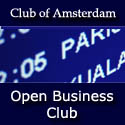 | Club of Amsterdam Open Business Club Are you interested in networking, sharing visions, ideas about your future, the future of your industry, society, discussing issues, which are relevant for yourself as well as for the ‘global’ community? The future starts now – join our online platform … |










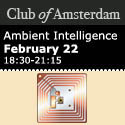
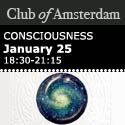
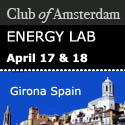





Customer Reviews
Thanks for submitting your comment!